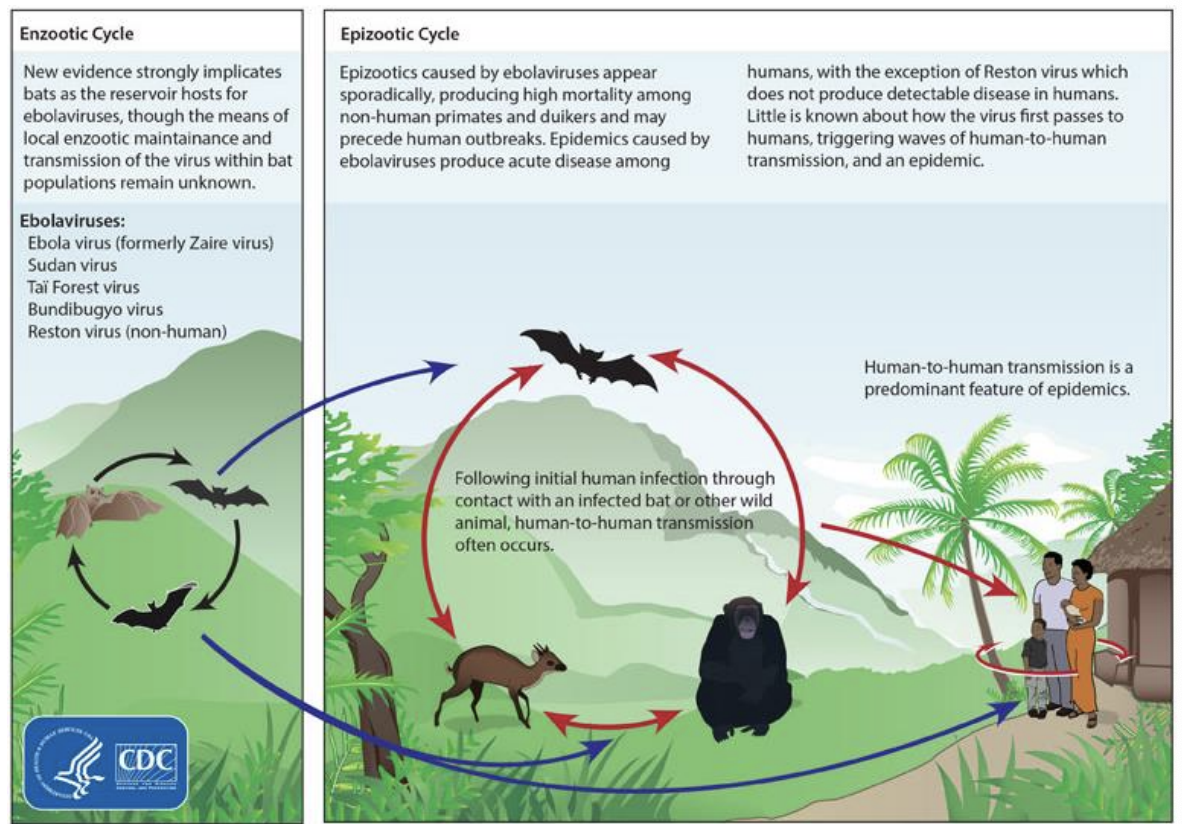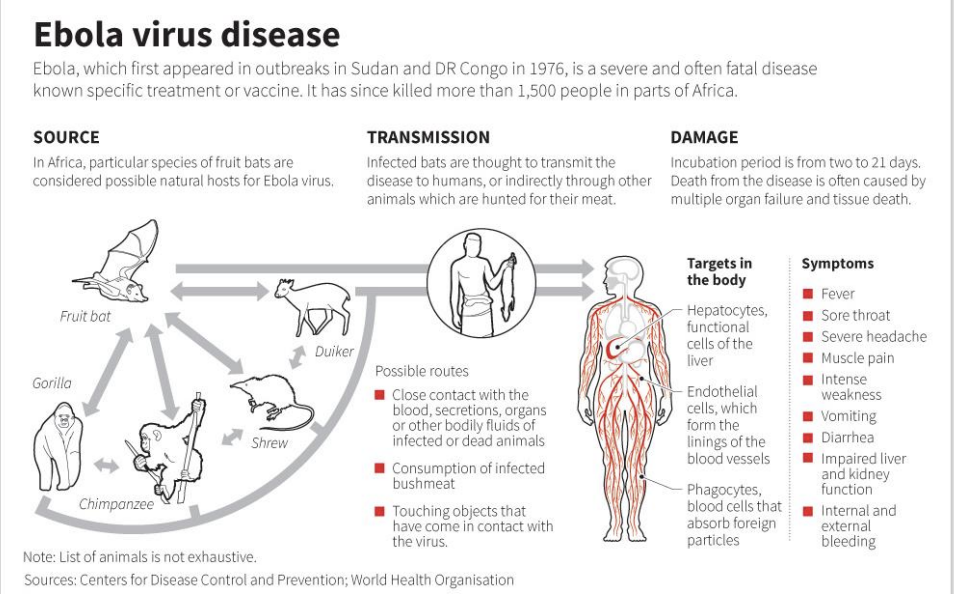microbio lecture 20 (microbes & public health)
1/28
There's no tags or description
Looks like no tags are added yet.
Name | Mastery | Learn | Test | Matching | Spaced |
|---|
No study sessions yet.
29 Terms
endemic
always present at a low frequency in a population
epidemic
larger-than-normal frequency of infection, rapid and direct human-human transmission
pandemic
an epidemic that occurs over a wide geographic area
prevalence
total number of active cases
incidence
number of new cases
systemic, syndromic, patient zero
how to stop an epidemic in its tracks:
track diseases through ______ surveillance or _____ surveillance
identify an outbreak of an emerging or known disease
track down ___ ____/index case and identify close contacts
for emerging diseases, determine disease etiology (cause of disease, method of transmission and infection)
develop effective interventions and treatments
HIV
A retrovirus:
An estimated 1.14 million people in the United States were living with HIV at the end of 2016, the most recent year for which this information is available. Of those people, about 14.2% did not know they were infected
Risk factors: black/african american male-to-male sexual contact highest, highest in the south and new york
individual
Why are statistics important:
• Understanding an ______’s risk of contracting an illness based on population-level trends is key to targeting our prevention efforts
HIV prevention
decrease viral loads through treatment of infected individuals → lower rates of transmission
destigmatization + easily available HIV testing + sexual education → lower rates of transmission
pre-exposure prophylaxis → lower rates of transmission
HIV treatment
Three categories of drugs
Nucleoside analogs that inhibit reverse transcriptase-AZT is one example of this class. These analogs can be added to a growing chain but prevent the addition of the next base
Nucleoside reverse transcriptase inhibitors. These compounds interact directly with the enzyme and alter the catalytic site
Protease inhibitors. These bind to and block the activity of the HIV protease preventing the processing of the polyproteins
The most effective therapy has been a cocktail of several different drugs--typically a protease inhibitor and two nucleoside analogs
nucleoside analogs, nucleoside reverse transcriptase inhibitors, protease inhibitors
HIV treatment, three categories of drugs:
_____ _____ that inhibit reverse transcriptase - AZT (azidothymidine) is one example of this class. These analogs can be added to a growing chain but prevent the addition of the next base
_____ _____ _____ _____. These compounds interact directly with the enzyme and alter the catalytic site
____ ______ These bind to and block the activity of the HIV protease preventing the processing of the polyproteins
azidothymidine (AZT)
HIV drug category:
Nucleoside analogs that inhibit reverse transcriptase
______ is one example of this class. These analogs can be added to a growing chain but prevent the addition of the next base
nucleoside reverse transcriptase inhibitors
HIV drug category:
These compounds interact directly with the enzyme and alter the catalytic site
protease inhibitors
HIV drug category:
These bind to and block the activity of the HIV protease preventing the processing of the polyproteins
HIV treatment caveats
Expensive--Approximately $10,000 per year per patient. This leads to two classes of patients: those that can afford treatment and those that cannot
Side effects: Fatigue, Anemia, Body Shape Changes (Lipodystrophy), Diarrhea, Peripheral Neuropathy, Mitochondrial Toxicity, Bone Problems
Patients who discontinue use have an immediate rebound in viral levels
Drug resistant strains
HIV does not cause symptoms for 3-12 months after infection – regular testing is important!
vertically transmitted
Children of HIV-positive mothers are at risk of acquiring HIV
HIV can be ____ _____:
During pregnancy through the placenta
During vaginal childbirth
Through breastfeeding
If a mother’s viral loads are undetectable, chance of transmission during pregnancy or through breastfeeding are <1%
PrEP (pre-exposure prophylaxis)
Medication that reduces the risk of contracting HIV
From sex – ~99% decrease
From IV drug use – at least 74% decrease
Two approved daily oral medications, 1 approved weekly shot
Some side effects (headache, nausea, loss of appetite) are common; less common side effects include kidney and liver damage
very high mutation rate
Why are vaccines for retroviruses notoriously difficult to develop?
What “feature” of retroviruses make development of live virus vaccines difficult
HIV vaccine
Live attenuated virus could integrate in to host cell’s DNA and cause disease
HIV has a high mutation rate and it is difficult to make a vaccine against all clades
mRNA vaccine technology is limited by how much mRNA you can have in a single vaccine (one protein vs. many)
There have been >250 HIV vaccine trials
neglected tropical diseases
diseases that “share features that allow them to persist in conditions of poverty, where they cluster and frequently overlap.
ex: cholera and dengue
dengue
The most common mosquito-borne viral disease of humans
Globally, half of the world’s population lives in areas where dengue viruses can be transmitted
Transmitted by the Aedes aegytpi mosquito, there are four distinct, but closely related, viruses that cause dengue.
Immunity to one serotype confers only partial and transient protection against subsequent infection by the other three

dengue symptoms
Infants and young children may have a non-specific febrile illness with rash.
Older children and adults may have either a mild fever or the classical incapacitating disease with abrupt onset and high fever, severe headache, pain behind the eyes, muscle and joint pains, and rash.
dengue haemorrhagic fever symptoms
s a potentially deadly complication that is characterized by high fever, haemorrhagic phenomena-- often with enlargement of the liver--and in severe cases, circulatory failure.
The fever usually continues for two to seven days and can be as high as 40-41°C, possibly with febrile convulsions.
In moderate DHF cases, all signs and symptoms abate after the fever subsides.
In severe cases, the patient's condition may suddenly deteriorate after a few days of fever; the temperature drops, followed by signs of circulatory failure, and the patient may rapidly go into a critical state of shock and die within 12-24 hours, or quickly recover if blood pressure is maintained
dengue treatment
there is no specific treatment for dengue fever
With appropriate intensive supportive therapy, mortality may be reduced to less than 1%
Maintenance of the circulating fluid volume is the central feature of DHF case management
For less severe cases, treatment focuses on pain and fever management
dengue prevention
Until 2022, the only method of controlling or preventing dengue and DHF was to combat the vector mosquitoes.
In Asia and the Americas, Aedes aegypti, the major vector for Dengue virus, breeds primarily in man-made containers. In Africa it also breeds extensively in natural habitats such as tree holes and leaf axils.
In recent years, Aedes albopictus, a secondary dengue vector in Asia, has become established in the United States, several Latin American and Caribbean countries, in parts of Europe and in one African country.
Vector control is implemented using environmental management and chemical methods.
A vaccine for dengue was approved in 2022 for children 9-16 years of age
Only approved for those with previous dengue infection in areas where dengue is endemic – not for travelers
ebola

ebola transmission
is generally difficult to transmit person to person
→ Transmission requires close contact with bodily fluids of infected individuals or consumption of infected meat

ebola 2015 outbreak
West African health care workers were unfamiliar with the disease, mistaking it for other diseases including Lassa Fever and Malaria
Rapid spread to cities made it difficult to control
Lack of properly staffed and stocked health care facilities
Failure of national and international groups including WHO to recognize serious nature of the outbreak early on (March 2014)
Failure of same to respond even when serious nature of outbreak became obvious
General belief that Ebola was a rare disease that was difficult to transmit*
rVSV-ZEBOV
vaccine for ebola
a recombinant, replication-competent vaccine. It consists of a vesicular stomatitis virus (VSV), which has been genetically engineered to express a glycoprotein from the Zaire ebolavirus so as to provoke a neutralizing immune response to the Ebola virus.
It was created by scientists at the National Microbiology Laboratory in Winnipeg, Manitoba, Canada
PHAC licensed it to a small company, NewLink Genetics, which started developing the vaccine; NewLink in turn licensed it to Merck in 2014. It was used on an emergency basis in Guinea in March 2016 and during the 2017 Democratic Republic of the Congo Ebola virus outbreak. It was approved by the FDA in 2019 for health care workers with occupational exposure risks.